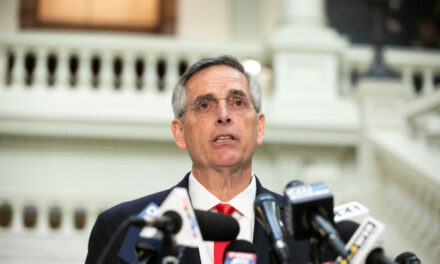We support our Publishers and Content Creators. You can view this story on their website by CLICKING HERE.
Trump unveiled a series of economic policies in a speech in New York as the campaign seeks to contrast the platform with Harris’s ahead of next week’s debate.
Former President Donald Trump unveiled plans for a 15 percent tax rate for companies that produce goods in the United States, a commission to conduct an audit of the federal government, and the clawback of unspent funds authorized under the Inflation Reduction Act.
He added that billionaire Elon Musk, who proposed the idea of the commission, agreed to lead the efficiency panel.
In remarks to the Economic Club in New York on Sept. 5, Trump outlined new economic policies as the campaign looks to contrast his platform against Vice President Kamala Harris’s ahead of the debate next week.
Other provisions of Trump’s plan include increasing domestic energy production, ending subsidies for so-called green energy projects, decreasing federal regulations, attacking government waste and mismanagement, and increasing tariffs to spur domestic manufacturing.
Trump’s speech was made a day after Harris unveiled a proposal to give small business tax breaks and increase the top capital gains tax rate to 28 percent, breaking from President Joe Biden’s budget proposal that she had previously endorsed.
Some 97 percent of Americans named jobs and the economy as either “important” or “very important” in their thinking. In the same poll, 63 percent said the country is on the wrong track.
Both candidates released their plans just ahead of the first, and so far, only, planned presidential debate on Sept. 10. Both aim to convince voters that they can be trusted to bring back jobs, make housing more affordable, and reduce the cost of gasoline and groceries.
Domestic Production
Trump also highlighted tax incentives aimed at increasing U.S. manufacturing capacity. The keystone of the plan is a reduction in the corporate tax rate from 21 percent to 15 percent exclusively for companies that make their products in the United States.
“My message is simple,” Trump said. “Make your product here in America, and only in America. We are not going to be taken advantage of anymore.”
Trump also promised expanded tax credits for research and development, a 100 percent bonus depreciation, and expensing for new manufacturing investments.
The former president suggested that he would raise tariffs on imports to spur domestic production.
He credited his tariff policy for “opening up a higher and better destiny” for Americans. “We have to take care of our own nation and her industries first,” he added.
During his administration, Trump levied tariffs on billions worth of Chinese imports over Beijing’s unfair trade practices. The Biden administration has retained and broadened these tariffs.
At campaign rallies, Trump has repeatedly said he would raise China tariffs to 60 percent and apply at least 10 percent tariffs on goods imported from other countries.
Commission, Government Spending
The former president announced that he would create a government efficiency commission at Musk’s suggestion. The commission would be tasked to conduct a financial and performance audit of the federal government and make recommendations for reform, he said.
The Republican presidential nominee confirmed Musk has agreed to lead the task force.
This would be part of Trump’s broader regulatory overhaul efforts, he said, that would “liberate our economy from crippling regulations.”
He also pledged to eliminate a minimum of 10 current regulations for every new regulation imposed. This would build on Trump’s January 2017 executive order that called for slashing two regulations for every new one.
Trump’s plan would also claw back unspent funding from the $891 billion authorized over 10 years by the Inflation Reduction Act (IRA), a wide-ranging law authorizing spending on energy and climate change projects, subsidies for the Affordable Care Act, and expansion of the Internal Revenue Service.
The Biden administration considers the IRA to be one of its signature accomplishments, and Harris has said she was proud to make the tie-breaking vote for the bill in the Senate.
Other pillars of Trump’s wide-ranging economic plan include making the his tax cuts permanent and embracing future industries, like cryptocurrency.
Crypto has become a key plank in the GOP nominee’s economic plans, vowing to establish a national bitcoin strategic reserve.
US Dollar
On applying economic sanctions on countries, especially Russia, Trump said he would apply sanctions forcefully against those who deserve them, but later lift them strategically to preserve the dollar’s strength.
“I was a user of sanctions, but I’d put them on and take them off as quickly as possible, because ultimately it kills your dollar … it kills everything the dollar represents,” he said.
Losing the U.S. dollar’s status as the world’s reserve currency, he said, would be “equivalent of losing a war.”
Trump also said he would impose tariffs on countries that don’t honor the dollar as the world currency.
Harris’s Economic Plan
Meanwhile, Harris has unveiled key elements of her economic agenda in recent weeks.
Her economic plan includes a Child Tax Credit proposal, a federal ban on price gouging, $25,000 subsidies for first-time buyer housing, and a plan to build 3 million affordable homes by the end of her first term. She also hopes to expand on President Joe Biden’s efforts to bring down key prescription drug costs.
Arjun Singh and Terri Wu contributed to this report.

 Conservative
Conservative  Search
Search Trending
Trending Current News
Current News 







